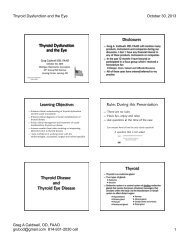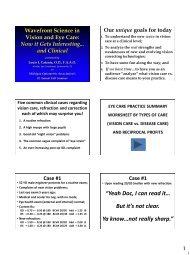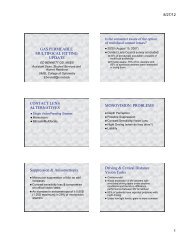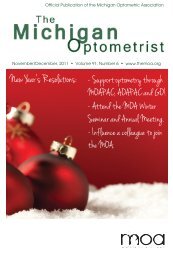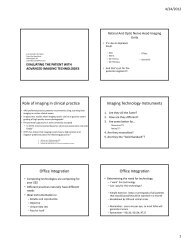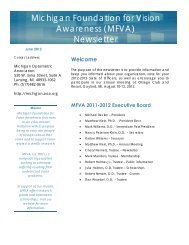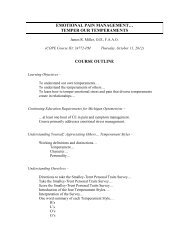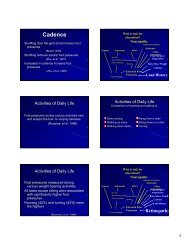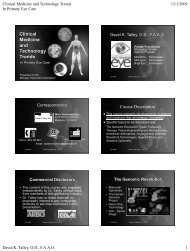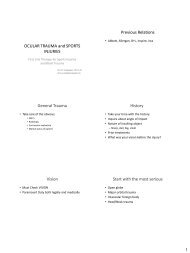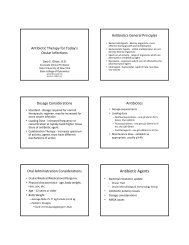Disclosures Basic Management Guidelines Giant Papillary ...
Disclosures Basic Management Guidelines Giant Papillary ...
Disclosures Basic Management Guidelines Giant Papillary ...
You also want an ePaper? Increase the reach of your titles
YUMPU automatically turns print PDFs into web optimized ePapers that Google loves.
The Great Mimickers<br />
MOA 2011<br />
Joseph P. Shovlin, OD, FAAO<br />
Northeastern Eye Institute<br />
Scranton, PA<br />
<strong>Disclosures</strong><br />
Allergan Pharmaceutical Advisory Panel<br />
AMO Global Medical Advisory Panel<br />
-Acanthamoeba Outbreak Panel (ad hoc)<br />
-Consultant<br />
Bausch & Lomb Scientific Advisory Panel<br />
-Global Steering Committee<br />
-Panel On Fusarium Keratitis (ad hoc)<br />
Ciba Vision Post-Market Surveillance Study Group<br />
-Johns Hopkins Adjudication Committee (ad hoc)<br />
Johnson & Johnson Global Professional Advisory Panel<br />
Speaker’s Bureau: Vistakon, Ciba Vision,<br />
CooperVision, Bausch & Lomb, AMO, Alcon,<br />
Genzyme<br />
Clinical Investigator (FDA): AMO, Ciba Vision,<br />
Vistakon, Allergan, CooperVision<br />
<strong>Basic</strong> <strong>Management</strong> <strong>Guidelines</strong><br />
• Generally best to remove contact lenses<br />
immediately.<br />
• Document condition carefully and should<br />
photograph, if possible.<br />
• Do not over-medicate but be sure to<br />
address any infectious or significant<br />
inflammatory process when indicated.<br />
Contact Lens Complications That Mimic Non‐Lens Related Anterior<br />
Segment Pathology<br />
• <strong>Giant</strong> <strong>Papillary</strong> Conjunctivitis<br />
• Contact Lens Induced Superior Limbic<br />
Keratoconjunctivitis<br />
• Contact Lens Related Pseudo-dendrites<br />
• Contact Lens Related Acute Red Eye<br />
Response and Infiltrates<br />
<strong>Giant</strong> <strong>Papillary</strong> Conjunctivitis<br />
• Similarties and differences with vernal<br />
keratoconjunctivitis: size & shape of<br />
papillae, symptomotology, corneal<br />
findings<br />
• Additional conditions to consider:<br />
chlamydia, pyogenic granuloma, floppy eyelid<br />
syndrome, lid imbrication, atopic keratoconjunctivitis,<br />
molluscum contagiosum, sarcoid nodules, Wegener’s,<br />
bacterial conjunctivitis
Contact Lens Induced Superior Limbic<br />
Keratoconjunctivitis (SLK)<br />
• Similarities/differences with Theodore’s SLK<br />
(idiopathic): associated thyroid disease, bilateral<br />
presentation, location & severity of conjunctival<br />
findings, corneal features including stem cell<br />
dysfuction<br />
• Additional conditions to consider: lid meniscus<br />
staining, epithelial splitting, herpes simplex<br />
keratoconjunctivitis, chlamydia, episcleritis,<br />
limbal follicles, sebaceous gland carcinoma<br />
<strong>Management</strong> of GPC<br />
• Always address the patient, lens and<br />
wearing schedule.<br />
• Suggested changes include replacement<br />
cycle, material & design, accoutrement<br />
and wearing schedule<br />
• Pharmaceuticals: mast cell stabilizers<br />
(type 1 response), NSAIDs, antihistamine/decongestants,<br />
soft steroids,<br />
lubrication
Case 7 ‐‐ corneal haze Stem Cell Deficiency
Contact Lens Related Pseudodentrites<br />
• Similarities/differences with HSV keratitis:<br />
raised/excavated, staining patterns, bilateral<br />
presentations, adnexa features (skin involvement)<br />
Additional conditions to consider: Richner-Hanhart<br />
Syndrome (Tyrosinemia), Thygeson’s SPK,<br />
edematous corneal formations, corneal verticilatta,<br />
healing abrasions, stromal dystrophy,<br />
medicamentosa, acanthamoeba keratitis<br />
<strong>Management</strong> of CL Induced Superior Limbic<br />
Keratoconjunctivitis<br />
• Hiatus from lens wear<br />
• Address patient, lens and wearing<br />
schedule<br />
• Frequent lubrication recommended<br />
• Pharmaceuticals: steroid or<br />
antibiotic/steroid combination for<br />
inflammation, NSAIDs (limited value),<br />
mast cell stabilizer, cyclosporine
Herpes Simplex Corneal Lesions<br />
The early and late presentation<br />
Case 14 ‐ painless Herpes Simplex<br />
(not a classic dendrite)<br />
Resolving Herpes Simplex skin lesions<br />
on upper lid after 9 days<br />
Both Stains ?? Additional Value
DIAGNOSTIC CONFUSION WITH<br />
DENDRIFORM LESIONS OF THE CORNEA<br />
• Acanthamoeba elevated corneal line<br />
• Herpes simplex dentrite<br />
• Herpes zoster keratopathy<br />
• Contact lens “pseudo-dendrite”<br />
• Thygeson’s superficial keratopathy<br />
• Tryosinemia (Richner-Hanhart)<br />
• Other corneal fascinations-edematous formations,<br />
verticillata, filaments, stromal dystrophy, post PK<br />
hypertrophic epitheliopathy
Differential Diagnosis of Ulcerative<br />
Lesions<br />
• Herpes simplex keratitis<br />
• Neurotrophic keratitis<br />
• Peripheral marginal infiltrates<br />
• Chemical keratopathy<br />
• Keratoconjunctivitis sicca<br />
<strong>Management</strong> of Pseudodentrites<br />
• Attempt to determine causea: Hypoxia,<br />
antigen deposition, solution toxicity.<br />
• Depending on the cause (if known):<br />
increase oxygen flux, change solutions,<br />
lubrication with lens wear, replace lens<br />
more often.<br />
• Pharmaceuticals: antibiosis (usually not<br />
required), soft steroids, lubrication.<br />
Contact Lens Associated Infiltrative<br />
Keratitis (CLAIK)<br />
• Is this really a different entity by<br />
classification systems?<br />
• Relative increase recently noted (Carnt,<br />
Kislan, Keic)<br />
• Disproportionate number of cases with<br />
certain lens/solutions (combinations)<br />
• Easily managed, but a nuisance to<br />
patients and practices<br />
Contact Lens Acute Red Eye Response<br />
(CLARE)<br />
A syndrome of conjuctival injection, infiltrative keratitis<br />
and epitheliopathy<br />
Multi‐factor etiology: hypoxia, trapped debris or<br />
deposits, solution preservative, prolonged wearing time,<br />
low grade bacterial response (bioburden), response to<br />
mechanical trauma<br />
Must rule out other lens or non‐lens related causes:<br />
adenoviral keratoconjunctivitis, HSV keratoconjunctivitis,<br />
Epstein‐Barr keratoconjunctivitis, Thygeson’s SPK,<br />
ulcerative keratitis and other non‐specific responses.<br />
Lipopolysaccharide Reaction<br />
• LPS response to lens bioburden<br />
• Toll-like receptors of the cornea are<br />
involved<br />
• Is there a disproportionate number of<br />
these reactions with certain lens<br />
type/MPDS combinations?
Factor Associated Not Associated<br />
Known Association with CIEs<br />
Improper lens care Bates 1989; Chalmers AAO 2004; Mah-Sadorra 2005; McNally, Chalmers ARVO 2004<br />
Sankaridurg 1998<br />
Lens Bioburden Holden 1996; Key 2000; Sankaridurg 1998; Sweeney ARVO 2003; Szczotka-Flynn IOVS 2010<br />
Case contamination Bates 1989; Holden 1996; Sankaridurg 1998<br />
Overnight/EW Bates 1989; Chalmers ARVO 2010; Cutter 1996; Donshik 1995; Efron 2005; Grant 1998; Mah-<br />
Sadorra 2005; Morgan BJO 2005, IOVS 2005; Nilsson 1994; Santodomingo-Rubido 2007;<br />
Stapleton 1992; Suchecki 1996; Vikoren 1990<br />
Smoking Chalmers 2007 (trend); Cutter 1996; Morgan IOVS 2005; McNally 2003; Szczotka-Flynn IOVS<br />
2010<br />
No Association with CIEs<br />
Suchecki 1996<br />
Corneal staining Szczotka-Flynn Arch Ophthalmol 2007 Szczotka-Flynn IOVS 2010<br />
PATH Carnt 2007 Willcox FDA 2008<br />
Gender Morgan IOVS 2005 Chalmers 2007, OVS 2010; Forister 2009;<br />
McNally 2003; Nilsson 1994; Sweeney<br />
ARVO 2003; Szczotka-Flynn IOVS 2010<br />
Rx Chalmers 2007 McNally 2003; Chalmers OVS 2010<br />
No Conclusive Consensus<br />
Age Chalmers AAO 2004, 2007, ARVO 2010; McNally 2003; McNally, Chalmers ARVO 2004 Morgan IOVS 2005; Sweeney ARVO 2003;<br />
Szczotka-Flynn IOVS 2010<br />
Lens care solution Carnt 2007, 2009; Chalmers ARVO 2010; Diec ARVO 2009, ARVO 2010; Kislan ARVO 2010;<br />
Willcox FDA 2008<br />
Soft contact lens material Brennan 2002; Carnt 2009; Chalmers 2010, ARVO 2010; Fonn 2002; Forister 2009 (trend); Keir<br />
2010; Morgan BJO 2005, IOVS 2005; Santodomingo-Rubido 2007; Sweeney ARVO 2003; US<br />
FDA, Bausch and Lomb 2001 (US); US FDA, CIBA Vision,2001; US FDA, Vistakon 2005 (US)<br />
Solution/Lens<br />
combinations<br />
Donshik 1995; Morgan IOVS 2005;<br />
Roseman 1994; Zigler 2007<br />
Dillehay 2007; Efron 2005; Fonn 2002, US<br />
FDA, CIBA Vision 2001 (US)<br />
Carnt 2007, 2009; Keir 2010; Kislan ARVO 2010 Diec ARVO 2009; Zigler 2007<br />
Mucin balls Carnt ARVO 2007; Sweeney ARVO 2003; Szczotka-Flynn IOVS 2010 (protective) Dumbleton AAO 1999; Tan AAO 1999<br />
Season Chalmers OVS 2010; Morgan IOVS 2005<br />
Duration of lens wear Chalmers 2007 Nilsson 2001<br />
Swimming Chalmers AAO 2004 ; McNally, Chalmers ARVO 2004 Morgan IOVS 2005<br />
Prior inflammatory event,<br />
CL-related issues, or injury<br />
Chalmers 2007; Ionides 1997; McNally 2003 Morgan IOVS 2005<br />
Conjunctival or limbal<br />
redness<br />
Szczotka-Flynn Arch Ophthalmol 2007 Carnt 2007; Sweeney ARVO 2003<br />
Risk Factor: Different SiHy Lens<br />
Materials Similar in Most Instances<br />
Factor Total Symptomatic<br />
% of subjects % of CIEs* % of subjects % of CIEs*<br />
Galyfilcon A 6.1% (4.7%) 14.3% (16.2%) 4.2% (3.1%) 17.9% (26.7%)<br />
Senofilcon A 5.7‐9.9% (6.2%) 22.9% (27.0%) 2.5% (2.4%)‐5.6% 10.3% (20.0%)<br />
Balafilcon A 0‐12.5% (5.9%) 22.9% (18.9%) 2.3‐5.7% (1.7%) 23.1% (13.3%)<br />
Lotrafilcon B 4.1% (3.3%) 11.4% (13.5%) 1.5% (0.7%) 7.7% (6.7%)<br />
Lotrafilcon A 2.4‐21.3% (7.4%) 28.6% (24.3%) 2.6‐9.9% (7.4%) 41.0% (60.0%)<br />
*Percent of CIEs calculated when there are at least 3 comparison arms.<br />
Brennan NA, et al. Ophthalmology. 2002;109:1172; Carnt NA, et al. Arch Ophthalmol. 2009;127:1616; Chalmers RL, et al. ARVO 2010; Poster<br />
D815; Diec J, et al. ARVO. 2009;50:E-Abstract 5633; Fonn D, et al. Clin Exp Optom 2002;85:176; Keir N, et al. Cont Lens Anterior Eye.<br />
2010;33:189; Kislan T, Hom MM. ARVO. 2010;51:E-Abstract 3424; Morgan PB, et al. Br J Ophthalmol 2005;89:430; Morgan PB, et al. Invest<br />
Ophthalmol Vis Sci. 2005;46:3136; Nilsson SE, Montan PG. CLAO J. 1994;20:225; Santodomingo-Rubido J, et al. Eye Contact Lens.<br />
2007;33:288; Sweeney DF, et al. ARVO. 2003;44:E-Abstract 3287; Szczotka-Flynn L, Diaz M. Optom Vis Sci. 2007;84:247; U.S. Food and Drug<br />
Administration. PureVision visibility tinted contact lens. Bausch and Lomb November 20, 2001; U.S. Food and Drug Administration. CIBAVision<br />
Focus Night and Day (lotrafilcon A) soft contact lens. October 12, 2001; U.S. Food and Drug Administration. Vistakon (senofilcon A) Contact<br />
Lens. August 20, 2004.<br />
Risk Factors for Corneal Infiltrates in<br />
Szczotka-Flynn 2007 Study<br />
In the study by Szczotka-Flynn and colleagues in 2007, the risk<br />
for corneal infiltrates was 7-times greater in those with corneal<br />
staining than for those without<br />
However, for the subset of eyes with significant CIEs, no variables,<br />
including corneal staining, were found to be significantly associated with<br />
an infiltrative event of grade 3 or 4 on univariate or multivariate analyses<br />
Szczotka-Flynn L, et al. Arch Ophthalmol. 2007;125(4):488.<br />
Risk Factor: Lens Care Solutions<br />
Factor Total 1,2 Asymptomatic 1 Symptomatic 1‐5<br />
% of subjects % of CIEs % of subjects % of CIEs % of subjects % of CIEs<br />
AQuify 11.7% 32.8% 6.6% 41.9% 4.6%‐5.1% 25.6‐29.8%<br />
Clear Care 1.6‐3.3% 5.7% 1.2% 9.7% 0.4‐0.7% 2.6‐5.4%<br />
Complete Easy Rub N/A N/A N/A N/A N/A 5.5%<br />
Opti‐Free Express 5.1% 14.3% 3.0% 19.4% 2.0% 10.3%<br />
Opti‐Free RepleniSH 16.8% 47.1% 4.6% 29.0% 10.2%‐12.2% 61.5%‐83.3%<br />
Renu fresh N/A N/A N/A N/A N/A 11.1%<br />
Renu • In sensitive a meta-analysis N/A of 4 comparable N/A studies: N/A N/A 0% 0%<br />
6<br />
• 0.5% of subjects using polyquad/Aldox-based solutions (both Opti-Free<br />
Express and Opti-Free RepleniSH) experienced bilateral CIEs<br />
• 0% of subjects using PHMB-based solutions (renu fresh, renu sensitive,<br />
and Biotrue) experienced any CIEs<br />
• However, several studies have found no difference in the rates of CIEs<br />
regardless of preservative or formula used7-11 1. Carnt NA, et al. Arch Ophthalmol. 2009;127:1616. 2. Diec J, et al. ARVO. 2010;51:E-Abstract 1538.<br />
3. Diec J, et al. ARVO. 2009;50:E-Abstract 5633; 4. Kislan T, Hom MM. ARVO. 2010;51:E-Abstract 3424. 5. Levy B, et al.<br />
Cornea. 1997;16:274. 6. Reindel W, et al. BCLA. 2009;80:Poster 10. 7. Donshik PC, et al. Trans Am Ophthalmol Soc.<br />
1995;93:49. 8. Dumbleton K, et al. Optom Vis Sci. 2006;83:758. 9. Morgan PB, et al. Invest Ophthalmol Vis Sci.<br />
2005;46:3136. 10. Roseman MJ, et al. AAO. 1994;Poster 20. 11. Zigler L, et al. Eye Contact Lens. 2007;33:236.<br />
Risk Factor: Lens/Solution Interactions<br />
Factor Total CIEs: Lowest CL<br />
Solution<br />
SiHy<br />
Total CIEs:<br />
Highest CL Solution<br />
Symptomatic CIEs:<br />
Lowest CL Solution<br />
Symptomatic CIEs:<br />
Highest CL Solution<br />
Galyfilcon A Clear Care = 2.1% RepleniSH =10.5% Clear Care = 0% RepleniSH = 7.9%<br />
Senofilcon A Clear Care = 0% AQuify = 20.0% Clear Care = 0% RepleniSH = 64.8%<br />
Balafilcon A Clear Care = 0% RepleniSH =10.3% Clear Care = 0% RepleniSH =17.9%<br />
Lotrafilcon B Clear Care = 2.8% RepleniSH =7.3% Clear Care = 0% RepleniSH =4.9%<br />
Lotrafilcon A Clear Care = 2.4% RepleniSH = 27.5% Clear Care = 2.4% RepleniSH = 27.5%<br />
Carnt NA, et al. Arch Ophthalmol. 2009;127:1616; Diec J, et al. ARVO. 2009;50:E-Abstract 5633; Kislan T,<br />
Hom MM. ARVO. 2010;51:E-Abstract 3424.<br />
Case 5
Tarantula Hairs
Case 12
Confocal Microscopy: Fungal Keratitis
Confocal Microscopy:<br />
Acanthamoeba Keratitis
MRSA<br />
• MRSA must be a consideration in any external ocular<br />
infection unresponsive to standard antibiotic therapy<br />
over 2 weeks<br />
• Suspicion for ocular MRSA must increase with:<br />
– Malignancy<br />
– Debilitating systemic disease<br />
– History of ocular surface disorder<br />
• Resistance to fluoroquinolones is increasing, even with<br />
4 th generation<br />
• Vancomycin and gentamicin remain effective<br />
treatments<br />
• Community-associated MRSA is an evolving ocular<br />
pathogen most often found in “hospital-naive” patients<br />
After 3 days of Abx<br />
Pharmaceuticals For CLAIK/CLARE<br />
• Appropriate hiatus from lens wear is<br />
needed.<br />
• Some controversy relative to need for<br />
antibiosis (single agent v.<br />
antibiotic/steroid combo.)<br />
• Steroids applied with caution often help.<br />
• Lubrication with un-preserved tears.<br />
Pseudo‐membrane<br />
<strong>Management</strong> of CLARE/CLAIK<br />
• Attempt to narrow cause(s); must take a<br />
careful look at patient’s lids.<br />
• Provide frequently replaced or<br />
disposable lenses with a reasonable<br />
wearing schedule.<br />
• Some consideration must be given to<br />
solution changes (oxidative).<br />
• Rigid lenses or refractive surgery may<br />
be best alternative if multiple episodes<br />
occur.<br />
Quote of the Month<br />
“If this is what I think it is, then I’m<br />
dead wrong” Rev. Jim Ignatowski<br />
(memorable character, Taxi, 1982)
• Thanks for attending!



